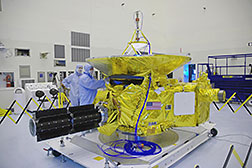- Number 445 |
- August 10, 2015
National labs put power behind NASA’s New Horizons mission to Pluto

The radioisotope thermoelectric generator
(black) undergoing testing during the
"hot fit check" in November 2005 prior to
the January 2006 launch, courtesy of NASA.
After a journey of three billion miles lasting more than nine years, NASA’s New Horizons mission finally flew by Pluto and its mysterious moons. The craft is powered by a radioisotope thermoelectric generator (RTG) that was assembled, tested and prepared for launch by researchers at DOE's Idaho National Laboratory.
New knowledge and scientific discoveries have been flowing from New Horizons since its closest approach to Pluto on July 14. The bounty of data will continue to trickle back to Earth for the next 16 months, and the craft's long journey will continue deep into the Kuiper belt — the vast region of icy objects and remnants of the formation of the solar system dating from more than 4 billion years ago.
The RTG power system uses heat from the natural decay of plutonium-238 to provide an uninterrupted and reliable source of electricity and heat in the remote and harsh environment of deep space. Los Alamos and Oak Ridge national laboratories contribute to the production of radioisotope heat sources, and the power conversion system was constructed by Lockheed Martin in Valley Forge, Pa. INL then assembled and tested the radioisotope thermoelectric generator (RTG) before delivering it to the NASA launch site.
This virtual tour of INL's Space and Security Power Systems Facility describes the similar process INL completed for the Mars Science Laboratory's Curiosity Rover.
“Not many people have to wait 10 years for the payoff of their hard work, but it is enormously gratifying to see the close-up imagery being beamed back,” said Stephen Johnson, director of INL's Space Nuclear Power & Isotope Technologies Division. “We still have many members of our team that supported the 2006 launch working here in Idaho, and the excitement about the new discoveries is really starting to build.”[Joe Campbell, 208.533.7783,
joseph.campbell@inl.gov]
